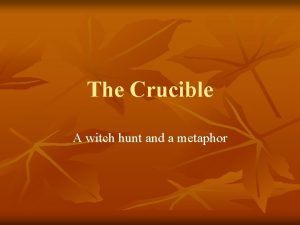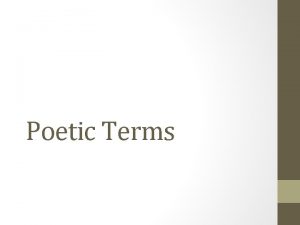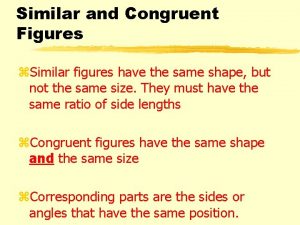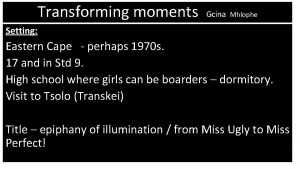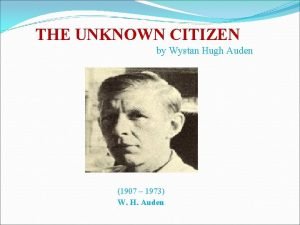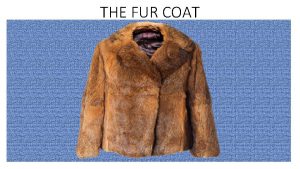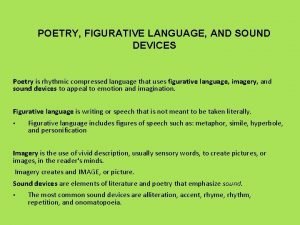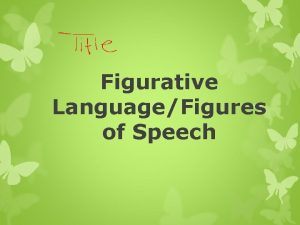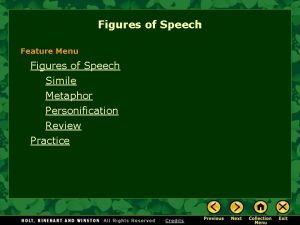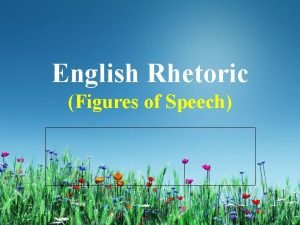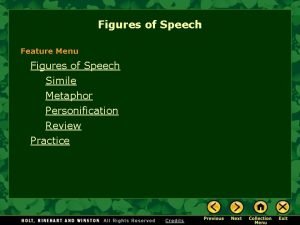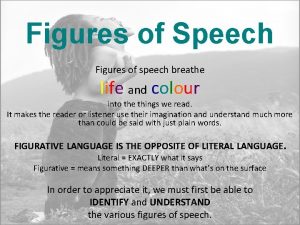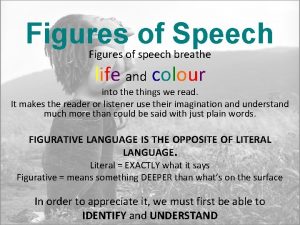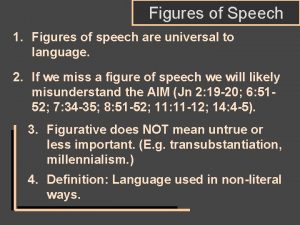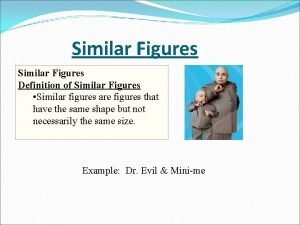CHAPTER 15 FIGURES OF SPEECH OR METAPHORICAL LANGUAGE












- Slides: 12

CHAPTER 15 - FIGURES OF SPEECH, OR METAPHORICAL LANGUAGE: A SOURCE OF DEPTH AND RANGE IN POETRY Lap 4: Poetry Day 4

MUSIC IS POETRY.

LITERARY DEVICES Figures of speech, metaphorical language, figurative devices, literary devices and rhetorical figures are terms describing organized patterns of comparison that deepen, broaden, extend, illuminate, and emphasize meaning. The literary devices that we will be studying this LAP are: metaphor, simile, imagery, paradox, anaphora, apostrophe, personification, synecdoche, metonymy, pun (paronomasia), synthesia and hyperbole.

METAPHORS The two most important figures of speech, and the most easily recognized, are metaphors and similes. A metaphor shows that something unknown is identical to something known and equates known objects or actions with something that is unknown or to be explained. Metaphors are words that suggest meanings that go beyond their literal meanings. Example: Katy Perry’s, Firework- “Baby you’re a firework. ”Comparing (you) to a firework.

SIMILES A simile shows that something unknown is similar to something known and illustrates the similarity or comparability to something unknown or to be explained. Similes are distinguishable from metaphors because they are introduced by “like” with nouns and “as” with clauses. Example: Katy Perry’s Firework- “Do you ever feel like a plastic bag” -Comparing you (a person) to a plastic bag and disposable.

PERSONIFICATION Personification is the attribution of human traits to abstractions or to nonhuman objects. Personification is another dramatic figurative device through which poets explore relationships to environment, ideals and inner lives. Example: John Keats, “To Autumn”- Conspiring with him to load and bless. – Can the seasons conspire?

HYPERBOLE Hyperbole is the overstatement and understatement to create emphasis. Hyperbole is an exaggeration for effect. Example: I am so tired I cannot walk another inch” or “I’m so sleepy I might fall asleep standing here”. These statements CANNOT be taken literally making them exaggerations.

ONOMATOPOEIA o o Onomatopoeia refers to words which sound is very close to the sound they are meant to depict. In other words, it refers to sound words whose pronunciation to the actual sound they represent. Example: grunt, huff, buzz and snap. . .

CHAPTER 16 - TONE: THE CREATION OF ATTITUDE IN POETRY Tone, a term derived from the phrase tone of voice, describes the shaping of attitudes in poetry. Each poet’s use of words governs the reader’s responses through denotation and connotation, seriousness or humor, irony, metaphors, similes, hyperboles, and other literary devices. The sentences within a poem must be just long enough to achieve the poet’s intended effect- no shorter and no longer.

“MY PAPA’S WALTZ” P. 828 -829 Read the poem as a class. Listen for the “s, ” “z” and “sh” sounds. What do you think these letter sounds represent? The simile: “But I hung on like death” means that the boy __________. (answer: would not let go) What two senses are used in this poem? (answer: the narrator’s father beating time on the narrator’s headsomething he does each time he gets drunk) (answer: smell and touch) What effect does the rhyming scheme have in the poem? (possible answer: describes the speakers actions)

Is it a comparison between two things? Yes No Does it use “like” or “as”? Yes Are they exaggerating too much or too little? No No Yes Simile Metaphor ? Too Much? Object or idea doing human things? Too Little? No Hyperbole Understatement Yes Personification

APPLY WHAT YOU KNOW You will be given a poem subject and literary device on a note card. PLEASE DO NOT WRITE ON THE NOTE CARD. Your task is to write a line for a five-six line poem using the literary device written on the card. You MAY NOT use the word of the subject in your line/poem. For example, if your subject is puppies- you may not use the word puppy (puppies) or dog(s) in your line/poem. Once each person in your group has written their line for the assigned literary device, you will compose your poem in the order to which it make the “most sense”. Some of these poems will be accurate and others will be funny. The objective is to assess your understanding of the literary devices (figurative language) as used in poetry and establishing a personal tone for effect.
 The crucible witch hunt game
The crucible witch hunt game An indirect reference
An indirect reference Anglo saxon history timeline
Anglo saxon history timeline A metaphorical phrase used to replace a concrete noun
A metaphorical phrase used to replace a concrete noun Congruent symbol
Congruent symbol A polygon with eight sides and eight angles
A polygon with eight sides and eight angles Washing machine solid or plane figure
Washing machine solid or plane figure Who is bulelwa in transforming moments
Who is bulelwa in transforming moments The unknown citizen theme
The unknown citizen theme Fur coat short story analysis
Fur coat short story analysis Two figure of speech that involve comparison are
Two figure of speech that involve comparison are Figures of speech and sound devices
Figures of speech and sound devices Figures of speech
Figures of speech
